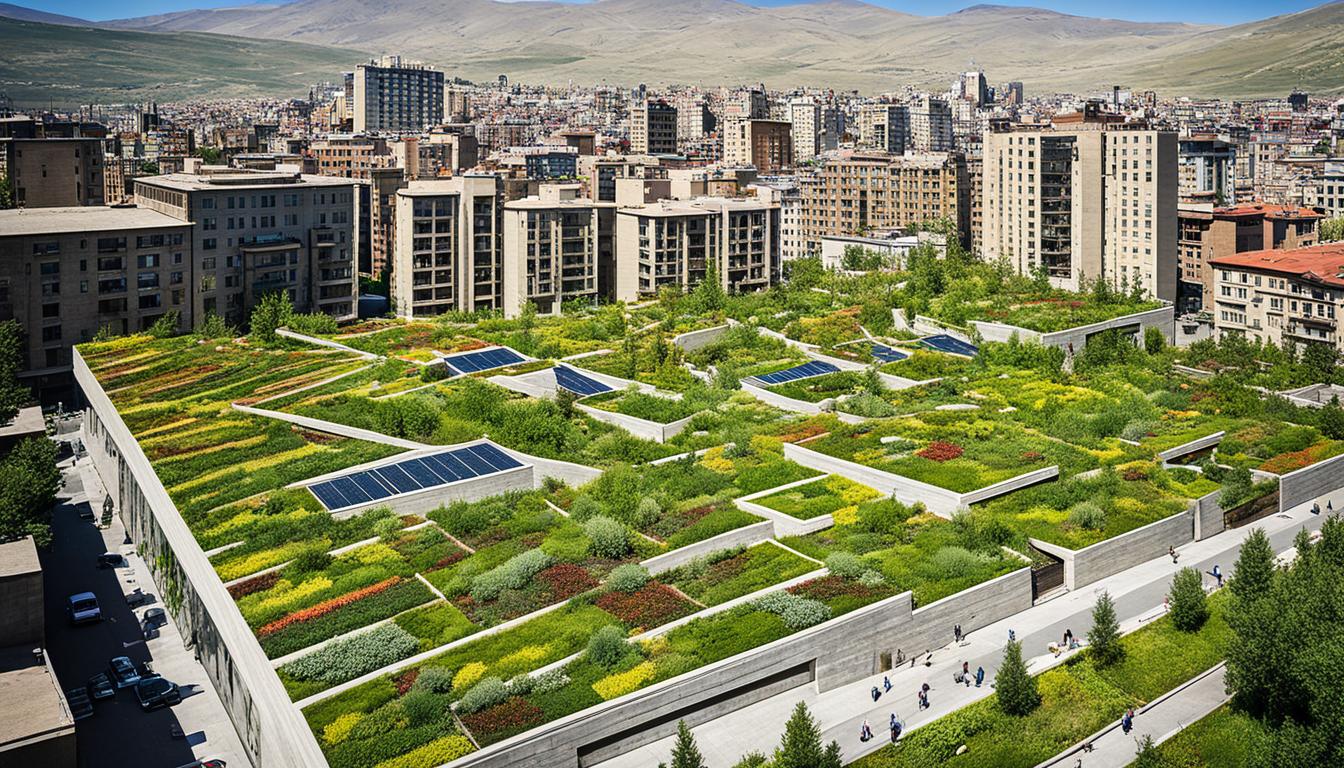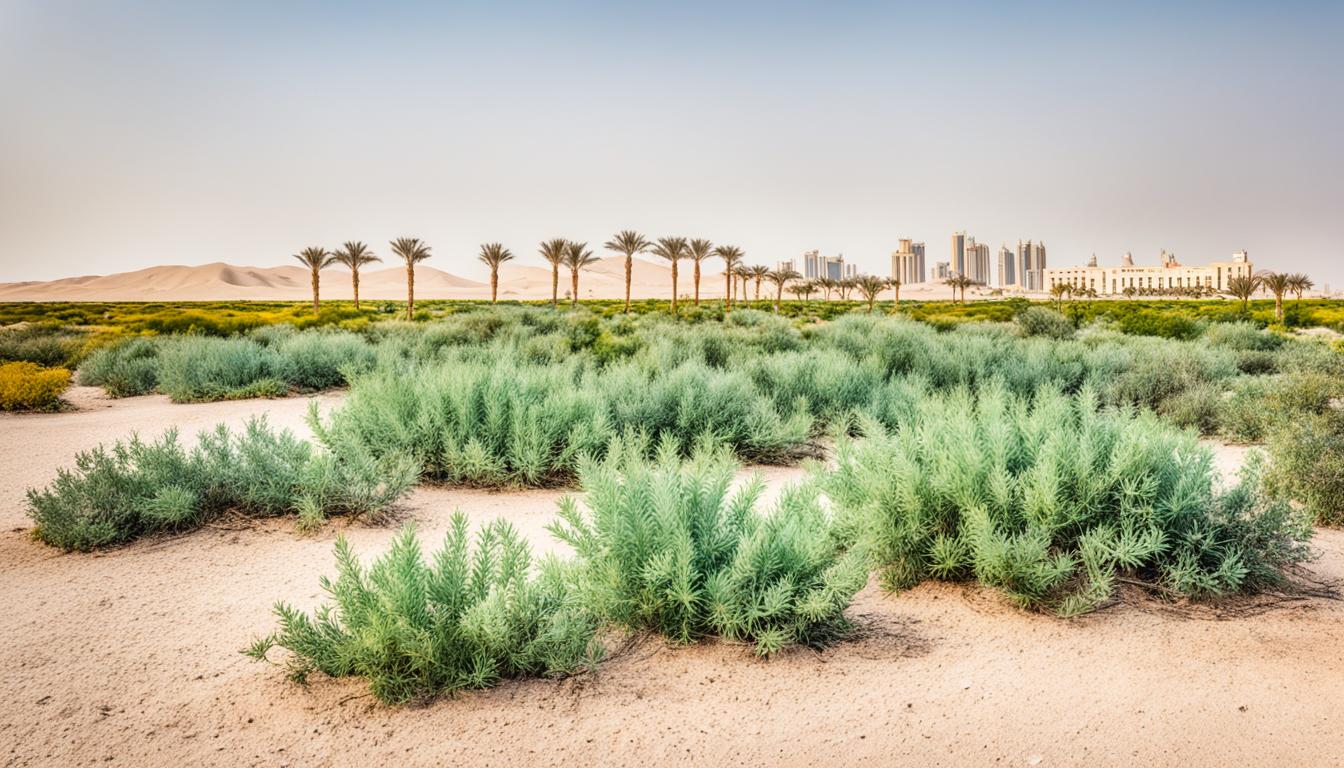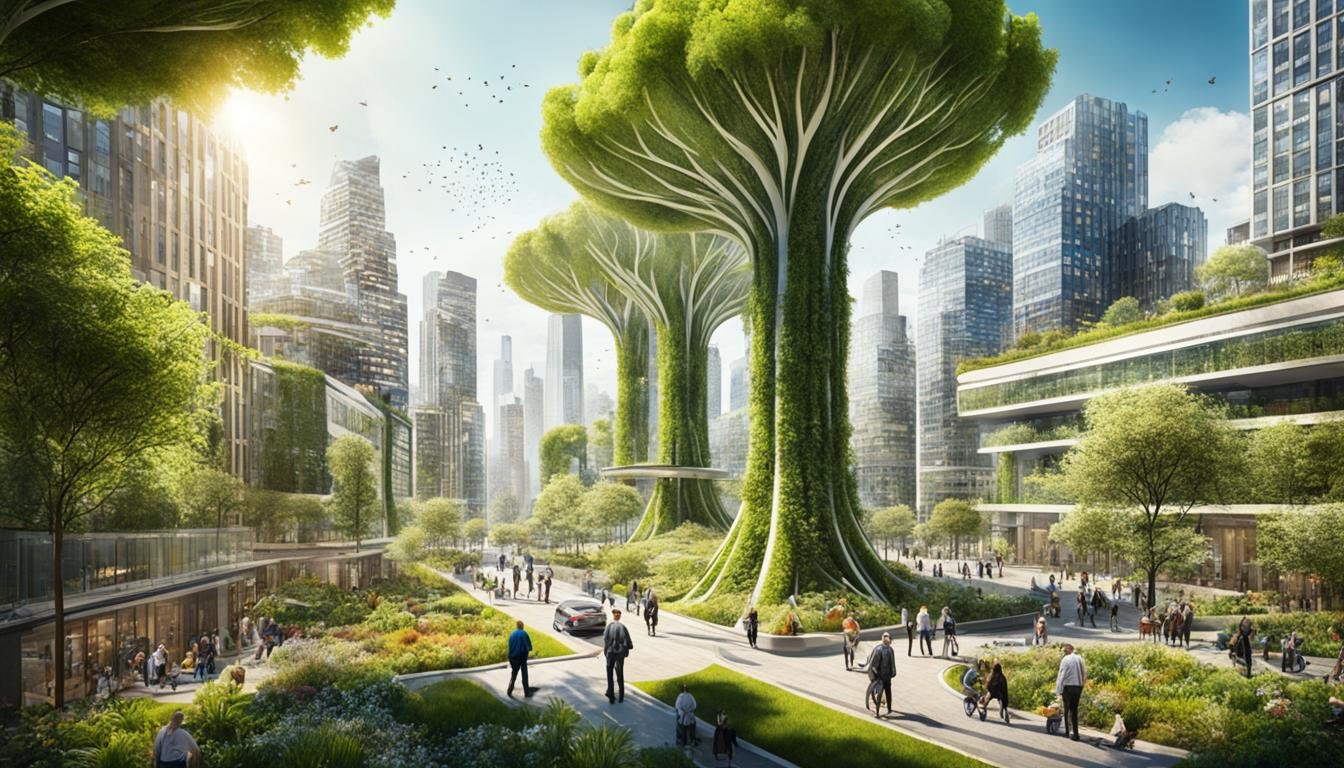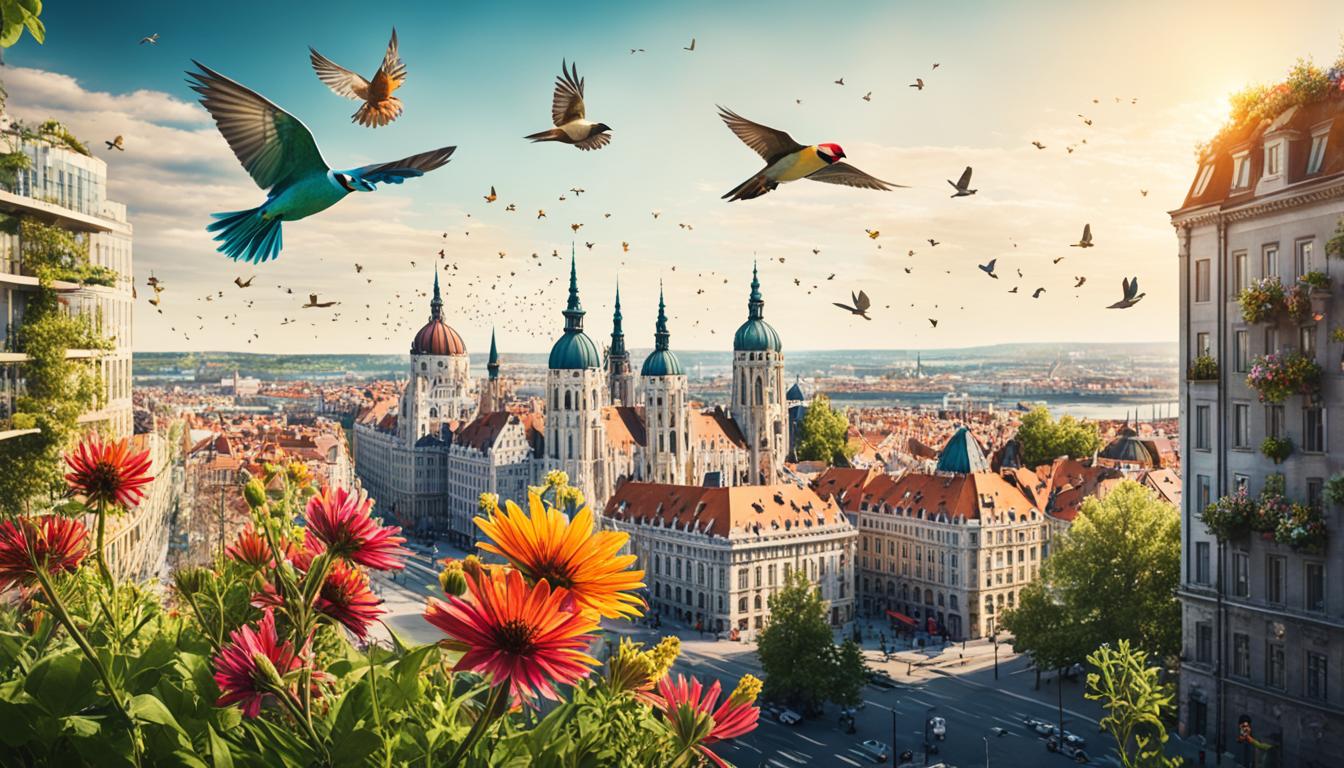Austria Biodiversity and the Built Environment
Austria is renowned for its stunning landscapes and diverse ecosystems, making it a haven for biodiversity. From the majestic Alpine regions to the lush forests and wetlands, Austria is home to a wide range of animal and plant species, each playing a crucial role in the delicate balance of the environment. However, as sustainable development and urban planning continue to shape the built environment, it is essential to prioritize environmental conservation and ensure the preservation of wildlife habitats and ecological sustainability.
Key Takeaways:
- Austria boasts a rich variety of animal and plant species, with iconic wildlife like the brown bear, golden eagle, and alpine roses.
- Habitat destruction, pollution, climate change, and invasive species pose threats to Austria’s biodiversity.
- Conservation efforts by environmental organizations, the government, and local communities are crucial for safeguarding biodiversity.
- The construction industry has a significant impact on biodiversity and needs to prioritize conservation alongside decarbonization efforts.
- Fostering biodiversity in the built environment can be achieved through green infrastructure and habitat preservation.
Exploring Austria’s Species Diversity
Austria is renowned for its remarkable species diversity, encompassing a wide array of animal and plant life. The country is home to numerous iconic species, including the majestic brown bear, agile alpine ibex, elusive European lynx, graceful red deer, agile chamois, powerful golden eagle, striking black grouse, wise eagle owl, and captivating capercaillie.
Furthermore, Austria boasts an astounding variety of flora, with over 3,000 plant species thriving within its diverse landscapes. These include rare orchids, delicate alpine roses, and the famous edelweiss, which has become a symbol of the country’s natural beauty.
Exploring Austria’s species diversity allows us to delve into the intricate web of life and gain a deeper appreciation for the importance of preserving their natural habitats. Whether it’s witnessing the mesmerizing flight of a bird species or marveling at the vibrant colors of a rare plant species, Austria’s biodiversity offers a myriad of wonders waiting to be discovered.
Austria’s extraordinary biodiversity is not only a source of fascination but also a testament to the country’s commitment to environmental conservation. Protecting these valuable habitats and safeguarding the diverse range of animal and plant species is crucial for maintaining a balanced and sustainable ecosystem.
| Animal Species | Plant Species |
|---|---|
| Brown bear | Rare orchids |
| Alpine ibex | Alpine roses |
| European lynx | Edelweiss |
| Red deer | |
| Chamois | |
| Golden eagle | |
| Black grouse | |
| Eagle owl | |
| Capercaillie |
Austria is a haven for wildlife enthusiasts and nature lovers, offering unparalleled opportunities to observe and appreciate the wonders of the natural world. By embracing sustainable practices and preserving these unique habitats, we can ensure the continued existence of Austria’s diverse species and contribute to global conservation efforts.
Threats to Austria’s Biodiversity
Austria’s biodiversity faces various threats that have the potential to disrupt its delicate balance. These threats include habitat destruction, pollution, climate change, and invasive species.
Habitat Destruction
The expansion of agriculture, urbanization, and infrastructure development pose significant risks to Austria’s biodiversity. These activities often lead to the fragmentation of natural habitats, resulting in a reduction of available space for many species. As their habitats are destroyed or altered, numerous plants and animals struggle to survive and adapt to the changing landscape.
Pollution
Pollution, caused by pesticides, fertilizers, and industrial chemicals, has detrimental effects on Austria’s environment. The contamination of air, water, and soil disrupts the delicate ecosystems and negatively impacts the health and reproduction of various species. Pollution not only directly harms organisms but also has far-reaching consequences for their habitats and food sources.
Climate Change
The effects of climate change present significant challenges to Austria’s biodiversity. As temperatures rise, natural habitats are being altered, affecting the distribution and behavior of many species. Changes in temperature and rainfall patterns disrupt the finely tuned balance between species and can lead to detrimental consequences for their survival. Species that are unable to adapt quickly enough may face a higher risk of extinction.
Invasive Species
Invasive species pose a serious threat to Austria’s native biodiversity. These non-indigenous species can outcompete native species for resources, disrupt natural ecological processes, and alter entire ecosystems. Invasive plants, animals, and microorganisms can spread rapidly, displacing local flora and fauna and causing imbalances in the natural environment.
It is crucial to address these threats and implement conservation measures to safeguard Austria’s biodiversity for future generations.
Conservation Efforts in Austria
Austria is committed to protecting its rich biodiversity through various conservation efforts. Environmental organizations, government initiatives, and local communities work together to promote sustainable practices and ensure the preservation of Austria’s natural heritage.
Leading the charge in conservation are prominent organizations such as the Austrian Academy of Sciences, Greenpeace Austria, and WWF Austria. These organizations actively engage in research, advocacy, and conservation projects to safeguard Austria’s diverse ecosystems and species.
“Conservation is not just about saving individual species; it’s about preserving the intricate web of life that sustains us all,” says Dr. Hans Müller, a renowned biodiversity scientist at the Austrian Academy of Sciences.
“We strongly believe in the power of collaboration and knowledge sharing among scientists, policymakers, and communities to address pressing conservation challenges and drive positive change.”
The Austrian government has also implemented several initiatives to protect the environment and promote sustainable practices. One notable initiative is the Austrian Biodiversity Strategy, which serves as a comprehensive framework for conservation efforts across the country. The strategy focuses on preserving and restoring habitats, promoting the sustainable use of natural resources, and raising public awareness about biodiversity conservation.
Conservation in Local Communities
Local communities play a vital role in biodiversity conservation. In the picturesque Hohe Tauern National Park, farmers, park rangers, and community members collaborate to promote sustainable agriculture and protect wildlife.
The Hohe Tauern National Park is a prime example of community-led conservation efforts. Farmers in the region practice environmentally friendly farming methods, minimizing the use of pesticides and fertilizers to preserve soil quality and prevent pollution. This sustainable approach not only protects the local ecosystem but also ensures the production of high-quality, organic products.
Park rangers work closely with the community to monitor wildlife populations and implement measures to safeguard vulnerable species. Together, they create a balance between human activities and nature, fostering coexistence and ensuring the long-term viability of the ecosystem.
“Our community takes pride in preserving the natural beauty of Hohe Tauern. We understand that by protecting wildlife and their habitats, we are securing a sustainable future for generations to come,” says Maria Schneider, a farmer and community activist in Hohe Tauern.
Raising Public Awareness
Public awareness and engagement play a crucial role in biodiversity conservation. Several initiatives across Austria aim to educate the public about the importance of sustainable practices and encourage individual actions.
Environmental organizations, in partnership with local communities and government agencies, organize workshops, seminars, and outreach programs to raise awareness about biodiversity conservation. These initiatives focus on topics such as habitat preservation, responsible consumption, and the benefits of sustainable living.
“By empowering individuals to make environmentally conscious choices, we can make a significant impact on biodiversity conservation. Every small action adds up to a more sustainable future,”
Andrea Richter, a spokesperson for Greenpeace Austria, emphasizes the significance of public engagement.
Furthermore, eco-tourism initiatives provide visitors with opportunities to explore Austria’s natural wonders while highlighting the importance of environmental conservation. Nature trails, guided tours, and eco-friendly accommodations promote a deeper understanding of the unique ecosystems and encourage visitors to become ambassadors for biodiversity protection.

Through collaboration between environmental organizations, government initiatives, and local communities, Austria continues to make significant strides in biodiversity conservation. By promoting sustainable practices, protecting habitats, and raising awareness, the country is paving the way for a sustainable future that embraces and preserves its natural treasures.
Challenges and Future Prospects
Austria is not exempt from the challenges faced by biodiversity worldwide. The country’s unique flora and fauna are threatened by biodiversity loss, climate change impacts, and a lack of awareness. The consequences of inaction are dire, as species extinction rates continue to rise and urbanization encroaches upon natural habitats. However, there is hope for a sustainable future through the implementation of conscious practices and the engagement of the public.
Sustainable practices play a vital role in mitigating the challenges faced by Austria’s biodiversity. Habitat protection and restoration are key factors in preserving the delicate balance of ecosystems. By safeguarding natural habitats and implementing sustainable land-use practices, we can safeguard the survival of countless species and maintain biodiversity for generations to come.
Preserving biodiversity is paramount, not only for the sake of Austria’s natural heritage but also for the entire planet. Ecological sustainability goes hand in hand with our own well-being, as biodiversity provides essential ecosystem services, from clean air and water to soil fertility and climate regulation.
An important aspect of overcoming ecological challenges lies in raising awareness about the value of biodiversity and the urgent need for conservation efforts. Educating the public about the importance of sustainable practices and the interdependence of all living organisms can inspire a collective sense of responsibility and action.

The Benefits of Preserving Biodiversity
Preserving biodiversity offers numerous benefits, including:
- Enhanced eco-tourism opportunities, attracting nature enthusiasts and contributing to sustainable local economies.
- Continued provision of ecosystem services, such as pollination, soil fertility, and natural pest control, which are vital for agriculture and human well-being.
- Genetic diversity within species, enabling adaptability to environmental changes and the development of new medicines and technologies.
It is essential to recognize that biodiversity conservation is not an isolated effort but a shared responsibility. Governments, organizations, and individuals must work together to implement sustainable practices, protect natural habitats, and promote awareness for a more resilient and thriving future.
| Challenges | Actions |
|---|---|
| Species extinction rates | Habitat protection and restoration |
| Climate change impacts | Sustainable land-use practices |
| Lack of awareness | Public education and engagement |
The Impact of Construction on Biodiversity
The construction industry plays a significant role in our society, fueling economic growth and development. However, it is important to recognize that the construction industry is resource-intensive and has a profound impact on biodiversity and natural habitats. The construction process, including the production of raw materials, can result in environmental damage and pose a threat to the delicate balance of our ecosystems.
Construction projects often require the clearing of land, resulting in the destruction of natural habitats and the displacement of wildlife. This habitat loss is a major contributor to the decline in biodiversity, as many plant and animal species depend on specific habitats for their survival. Additionally, the construction industry consumes vast amounts of resources and energy, leading to the emission of greenhouse gases and contributing to climate change.
Species extinction rates are increasing globally, and the construction industry’s impact on biodiversity cannot be ignored. It is essential that we recognize the environmental consequences of construction activities and take proactive measures to minimize these impacts.
One of the key environmental challenges posed by the construction industry is the loss of natural land and habitats due to urbanization and construction projects. As urban areas expand, they encroach upon existing natural habitats, fragmenting them and limiting the available space for many species. This fragmentation disrupts ecological connectivity, making it difficult for wildlife to migrate, find food, and reproduce.
Furthermore, the construction industry’s resource-intensive nature contributes to the depletion of natural resources and the destruction of ecosystems. The extraction of raw materials such as timber, sand, and stone can lead to irreversible damage to forests, rivers, and other natural environments. This extraction process not only directly impacts biodiversity but also results in the loss of ecosystem services and the disruption of ecological functions.
As the construction industry continues to grow, it is crucial to prioritize biodiversity conservation alongside decarbonization efforts. Integrating sustainable practices into construction processes can help minimize environmental damage and reduce the industry’s overall ecological footprint. This includes adopting eco-friendly building materials, implementing energy-efficient designs, and incorporating green infrastructure into urban developments.
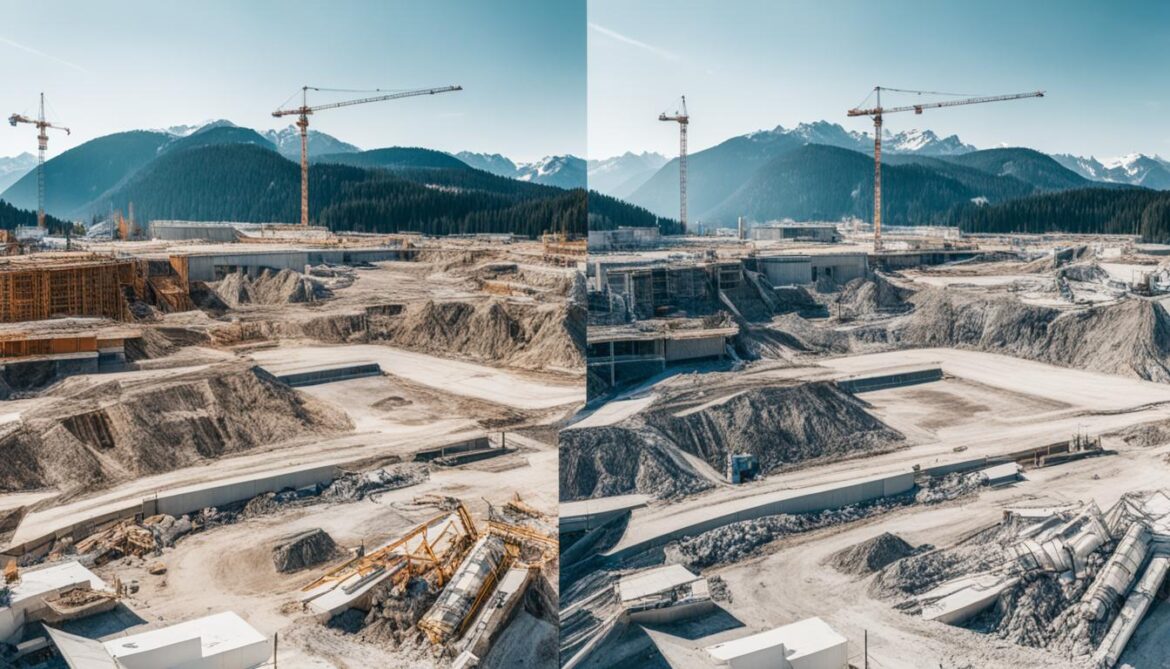
Fostering Biodiversity in the Built Environment
Biodiversity in the built environment plays a vital role in preserving ecological balance and promoting a sustainable future. To achieve this, several strategies can be implemented to create multi-species habitats and integrate green infrastructure. These initiatives involve the protection of existing habitats, the creation of habitat opportunities in new developments, and the incorporation of green roofs, green facades, and parks.
The integration of green infrastructure in urban areas provides valuable habitats for various wildlife species, including birds and pollinators. Multi-species habitats offer food sources, shelter, and breeding grounds, contributing to the preservation of biodiversity. Architects and urban planners are increasingly incorporating these principles into their designs, considering the needs of both humans and wildlife.
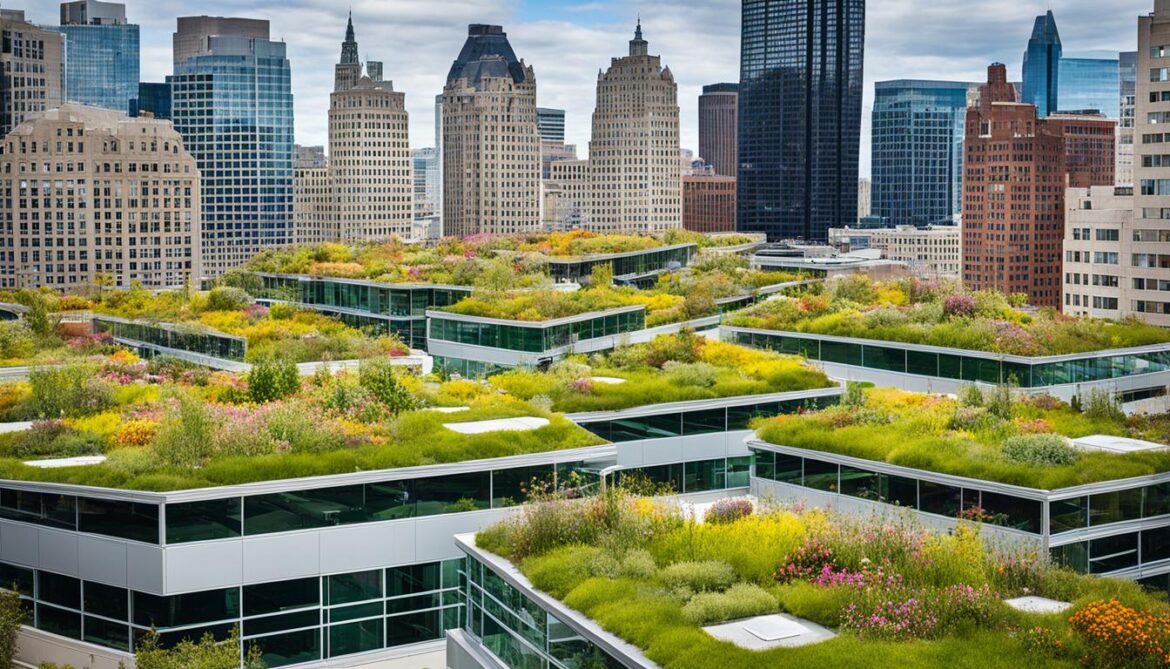
One example of sustainable architectural design is the Vertical Forest projects by Stefano Boeri Architetti. These innovative structures feature lush vegetation on vertical surfaces, creating a habitat for a diverse range of plant and animal species. The integration of biodiversity-friendly elements in architectural projects enhances the overall ecological value of the built environment.
“Integrating green infrastructure and creating multi-species habitats in urban areas not only promotes biodiversity conservation but also enhances the quality of life for residents by improving air and water quality, reducing the urban heat island effect, and providing recreational spaces.” – [Real Name], Environmental Architect
By fostering biodiversity in the built environment, we can contribute to habitat preservation and create sustainable spaces that benefit both humans and the natural world. Through collaborative efforts between architects, urban planners, environmental organizations, and communities, we can build a future where urban areas coexist harmoniously with nature.
| Benefits of Fostering Biodiversity in the Built Environment |
|---|
| Enhanced ecological sustainability |
| Improved air and water quality |
| Reduced urban heat island effect |
| Increased habitat opportunities for wildlife |
| Preservation of native plant species |
| Promotion of pollinator species |
| Creation of recreational spaces for residents |
Progress and Initiatives in Biodiversity Conservation
Significant progress has been made in recognizing the importance of biodiversity in the construction industry. Several initiatives around the world highlight the commitment to prioritize biodiversity conservation and integrate it into urban development.
Singapore City in Nature
Singapore has embarked on an ambitious transformation into a “City in Nature” to enhance its biodiversity. The city-state aims to create more green spaces, parks, and nature reserves, providing habitats for flora and fauna. By integrating nature into urban areas, Singapore is fostering a harmonious coexistence between the city and its natural environment. The National Parks Board of Singapore is leading this initiative.
UK BiodiverCities Initiative
The United Kingdom has launched the BiodiverCities initiative, recognizing the need to integrate nature-based solutions into urban planning. This initiative focuses on creating biodiverse cities by incorporating green infrastructure, such as parks, gardens, and green roofs. By enhancing urban biodiversity, the UK aims to create sustainable and resilient cities that benefit both people and nature. The Royal Society for the Protection of Birds supports the implementation of the BiodiverCities initiative.
Biodiversity Net Gain
The concept of Biodiversity Net Gain has gained traction in biodiversity conservation efforts. The approach requires new developments to demonstrate a 10% increase in biodiversity compared to the pre-development baseline. This ensures that development projects do not just avoid harm but actively contribute to protecting and enhancing habitats. The Biodiversity Net Gain approach is being implemented in various countries, including the UK, to mitigate the impact of urbanization on biodiversity.
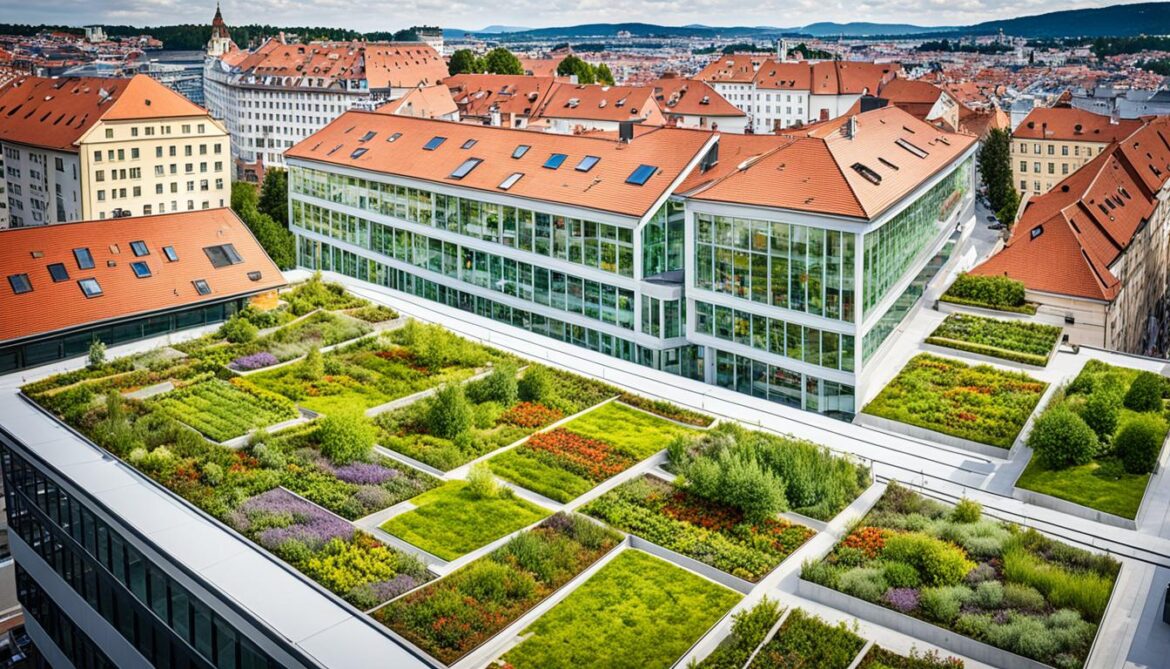
| Initiative | Country |
|---|---|
| Singapore City in Nature | Singapore |
| UK BiodiverCities | United Kingdom |
| Biodiversity Net Gain | Implemented globally |
The Tirol Living Lab for Climate Change Adaptation
The Tirol Living Lab is at the forefront of tackling climate change adaptation challenges in the built environment, forestry management, and wetland ecosystems. With its focus on natural capital and sustainable solutions, the lab plays a crucial role in ensuring the resilience of these vital systems.
The Tirol Living Lab aims to monitor and promote the development of small-scale nature-based solutions (NBS) in Tyrol. By integrating NBS into local and regional climate action plans, the lab ensures that these solutions are implemented effectively and contribute to climate change adaptation efforts.
The lab brings together stakeholders from various sectors, including government agencies, research institutions, and environmental organizations. This collaborative approach allows for the exchange of knowledge, expertise, and best practices, leading to innovative solutions that address the unique challenges facing Tyrol.
Forestry management is a key focus area for the Tirol Living Lab. With sustainable forestry practices, the lab aims to enhance the natural capital of forests, ensuring their long-term resilience and ability to adapt to climate change. Through research and practical implementation, the lab seeks to find the balance between conserving biodiversity and meeting the socio-economic needs of the region.
Wetland ecosystems are another crucial component of the Tirol Living Lab’s work. By understanding the role of wetlands in climate change adaptation, the lab develops strategies to protect and restore these valuable ecosystems. Wetlands play a vital role in water regulation, carbon storage, and providing habitats for diverse flora and fauna. Preserving and enhancing wetland ecosystems is essential for the overall resilience of the region.
The Tirol Living Lab is a testament to the commitment of Tyrol in addressing the challenges posed by climate change. By harnessing the power of nature-based solutions, the lab demonstrates the potential to create a more sustainable and resilient future for the built environment, forestry, and wetland ecosystems.
The Tirol Living Lab serves as a model for other regions in their efforts towards climate change adaptation and sustainable development. By learning from its innovative approaches and collaborative partnerships, communities worldwide can work towards preserving natural capital, managing forests responsibly, and safeguarding precious wetland ecosystems.
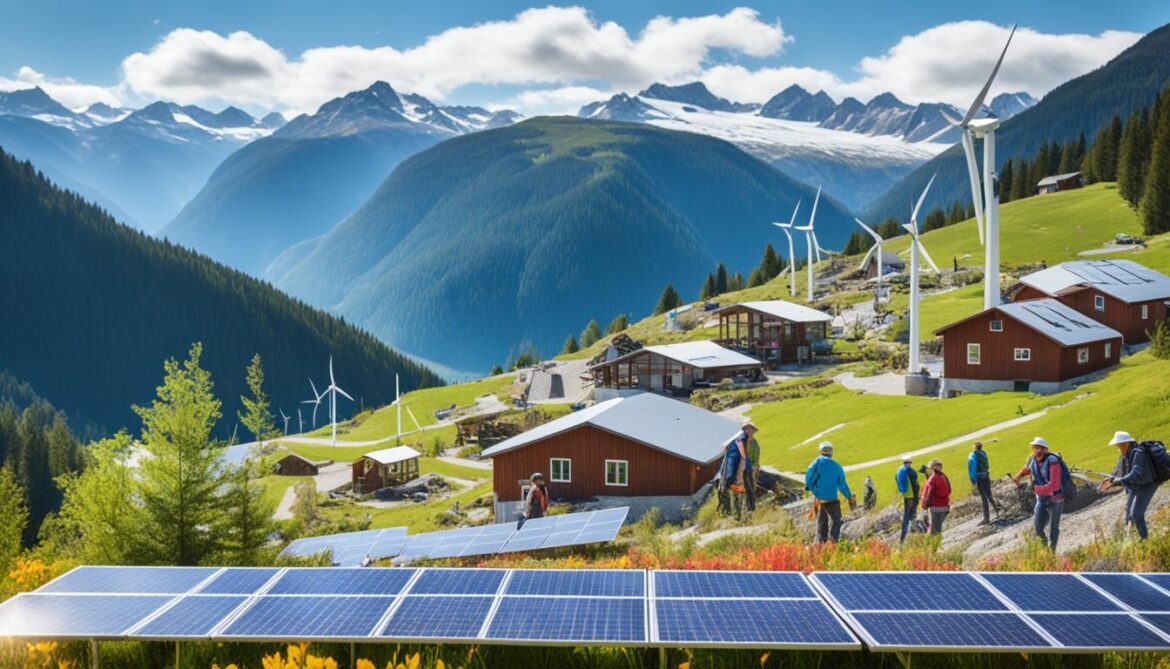
Prioritizing Biodiversity for a Sustainable Future
To ensure a sustainable future, prioritizing biodiversity is essential. Protecting habitats, promoting sustainable practices, and raising awareness are key strategies to preserve the rich biodiversity that our planet offers.
Conserving and Restoring Habitats
A crucial step in safeguarding biodiversity is conserving and restoring habitats. This involves preserving existing natural areas and implementing measures to reestablish degraded ecosystems. By protecting habitats, we can maintain diverse populations of flora and fauna, contributing to the overall balance of our ecosystems.
Promoting Sustainable Practices
Another way to prioritize biodiversity is through the promotion of sustainable practices. Sustainable resource use, such as responsible fishing and forestry practices, helps to mitigate the negative impacts of human activities on biodiversity. It also ensures the continued availability of vital natural resources for future generations.
Eco-tourism is another sustainable practice that supports biodiversity conservation. By visiting protected areas and engaging in responsible tourism activities, individuals can contribute to the local economy while promoting the preservation of natural habitats and wildlife.
Green Infrastructure: A Solution for Biodiversity
Incorporating green infrastructure into urban areas is a promising solution to mitigate the impact of human activities on biodiversity. Green roofs, green facades, and urban parks provide habitats for various species, helping to create interconnected ecosystems within cities. This integration of nature into urban spaces promotes biodiversity and enhances the quality of life for residents.
By investing in green infrastructure, we can create sustainable urban environments that prioritize biodiversity and support the overall well-being of communities.
Educating and Inspiring the Public
Biodiversity protection relies on the engagement of the public. Educating and raising awareness about the importance of biodiversity fosters a sense of responsibility and encourages individuals to take action.
Public awareness campaigns, educational programs, and community initiatives play a crucial role in fostering a sense of stewardship towards biodiversity. By actively involving the public in conservation efforts, we can build a network of supporters who are dedicated to protecting our natural heritage.
“The biodiversity of our planet is a testament to the beauty and resilience of life. It is our responsibility to prioritize its conservation and ensure a sustainable future for all.”
By prioritizing biodiversity, we can create a future where ecosystems thrive, wildlife flourishes, and the delicate balance of nature is preserved for generations to come.
Conclusion
Preserving Austria’s biodiversity is crucial for the country’s natural heritage and the delicate balance of the global ecosystem. Ongoing conservation efforts by organizations, government bodies, and local communities are making a significant impact. However, challenges such as biodiversity loss, climate change, and lack of awareness continue to pose a threat.
To ensure a sustainable and thriving future for Austria’s biodiversity, it is essential to prioritize its preservation. This can be achieved by promoting sustainable practices, protecting habitats, and engaging the public in conservation efforts. By adopting eco-friendly resource use, investing in eco-tourism, and integrating green infrastructure, we can mitigate the negative impact of human activities on biodiversity.
Education and public awareness play a crucial role in building support for biodiversity protection. By fostering a sense of responsibility and inspiring individuals to take action, we can collectively work towards a sustainable future where Austria’s rich biodiversity is conserved and celebrated for generations to come.



